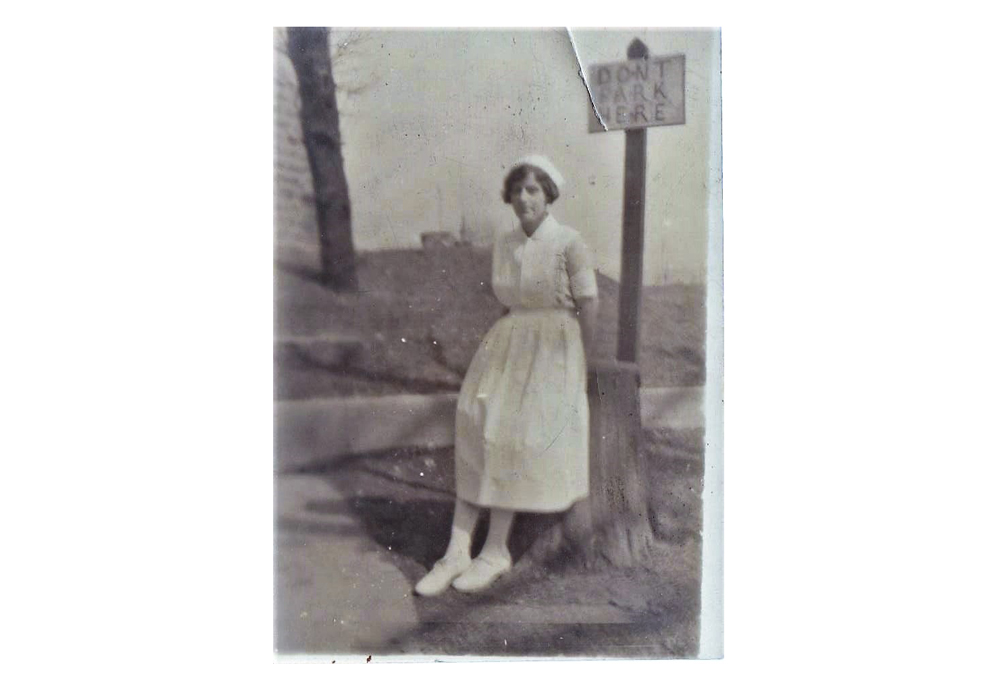Earlier this month, I found this picture of my grandmother from 1918. She must have sent it to her sister, because on the back of the photo was scrawled a message: “I thought you might want a snap to see me in my nursing uniform.” This is like a selfie from nearly a hundred years ago. Although the sign behind her says, “Don’t park here,” that’s exactly what she’s doing. The humor was not lost.
As the parent of a college senior in nursing school, I see a lot of selfies. It’s easy for this generation to save or send a selfie with a phone. They don’t think twice about it. Few of these selfies or group pictures ever get printed to paper, so the chance of a future generation ever seeing these might be less than it was for my grandmother a century ago.
My grandmother’s story wasn’t one captured by pictures. She travelled from Fort Madison, IA, to St. Louis, MO, in 1917 to obtain her diploma in nursing. I don’t think she ever looked back and regretted that decision. I suspect at the time, it took a lot of courage to leave your home as a young woman and travel alone by train to a strange city with just a single trunk of possessions to embark on an educational adventure. Prior to arriving, she had never been to St. Louis or seen a picture of where she would be going to school or living. She passionately wanted to be a nurse, and she followed her dream.
Nowadays, parents drop their children off at college in the thousands. It’s quite the event and requires countless hours of planning—and in many cases considerable financial investment. Most students don’t arrive by train without their parents or having never seen the campus, and today’s students bring much more than just a trunk. They come in vans packed to brim, which is usually followed by multiple trips to the store to get the remaining necessities. These students and parents arrive with the benefit of instant communication and a wide range of other resources that my grandmother could never have imagined. Students would be lost without their phones and laptops.
This generation of nurses approaches the world very differently than my grandmother, and it’s because of the world in which they grew up. In fact, for the past 20 years, Beloit College in Wisconsin has released something called the Mindset List, which is a catalog of social and historical facts that relate to the incoming freshmen class. It’s used to start discussion with faculty and students as they begin a new chapter in their lives. It also helps parents and faculty understand why the perspectives of current college students are often different from their own. Here are few items from Beloit’s list:
- This is the first generation for whom a “phone” has been primarily a video game, direction finder, electronic telegraph, and research library.
- Electronic signatures have always been as legally binding as the pen-on-paper kind.
- Amazon has always invited consumers to follow the arrow from A to Z.
- Their folks have always been able to get reward points by paying their taxes to the IRS on plastic.
- In their lifetimes, “blackberry” has gone from being a wild fruit to being a communications device to becoming a wild fruit again.
- By the time they entered school, laptops were outselling desktops.
- As toddlers they may have dined on some of that canned food hoarded in case of Y2K.
- Whatever the subject, there’s always been a blog for it.
- Women have always scaled both sides of Everest and rowed across the Atlantic.
- Bill Clinton has always been Hillary Clinton’s aging husband.
The Mindset Lists from past years also provide a lot of insight. The next generation of nurses lives in a world of instant communication and information. The challenge is helping them understand how to use those resources to provide stellar patient care. Nursing education still requires imparting a lot of information on many diverse topics. The challenge is teaching students how to think globally and to integrate all of that information to see the bigger picture.
Despite the extreme differences in student socialization that have occurred in the past century, similarities still exist. Every year students arrive, ready and excited to learn about the science of nursing. Many of these students leave their families to obtain their education. They make sacrifices to get the education and training they need to be excellent nurses. They want to make a difference for their patients. They wear their uniforms (albeit very different uniforms) with pride. They lean on each other as they study volumes of complex information. They socialize together after classes. And they take pictures to remember the special moments.






